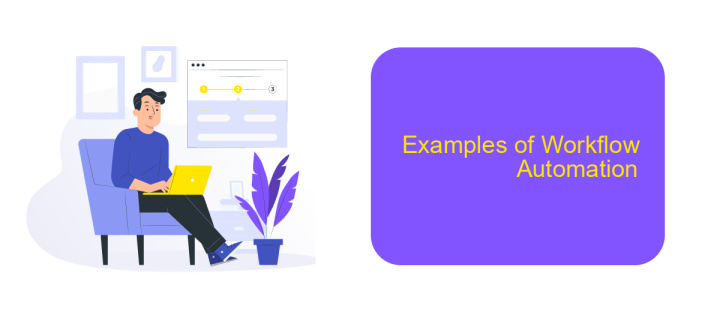Workflow Automation for Small Business
In today's fast-paced business environment, small businesses must find ways to streamline operations and increase efficiency. Workflow automation offers a powerful solution by automating repetitive tasks, reducing errors, and freeing up valuable time for more strategic activities. This article explores the benefits of workflow automation for small businesses and provides practical tips for implementing these solutions to drive growth and productivity.
Introduction
In today's fast-paced business environment, small businesses must optimize their operations to stay competitive. Workflow automation is a powerful tool that can help streamline processes, reduce manual errors, and save valuable time. By automating repetitive tasks, small businesses can focus more on their core activities and strategic growth.
- Improved efficiency and productivity
- Reduced operational costs
- Enhanced accuracy and consistency
- Better time management
Integrating various tools and applications can further enhance workflow automation. Services like ApiX-Drive enable seamless integration between different platforms, allowing data to flow effortlessly and eliminating the need for manual data entry. This not only simplifies complex processes but also ensures that all systems are up-to-date and synchronized. Embracing workflow automation can be a game-changer for small businesses looking to scale and succeed in a competitive market.
Benefits of Workflow Automation

Workflow automation offers numerous benefits for small businesses, significantly enhancing efficiency and productivity. By automating repetitive tasks, businesses can save valuable time and allocate resources to more critical activities. This not only reduces the likelihood of human error but also ensures that processes are completed consistently and accurately. As a result, employees can focus on strategic initiatives, fostering innovation and growth within the organization.
Moreover, workflow automation facilitates seamless integration between various tools and platforms. Services like ApiX-Drive enable businesses to connect different applications effortlessly, streamlining operations and improving data flow. This integration capability ensures that information is readily accessible, reducing delays and enhancing decision-making processes. Ultimately, workflow automation empowers small businesses to operate more efficiently, reduce operational costs, and maintain a competitive edge in the market.
How to Implement Workflow Automation

Implementing workflow automation in a small business can significantly improve efficiency and reduce human error. To get started, follow these steps:
- Identify repetitive tasks: List all the tasks that are repetitive and time-consuming.
- Select the right tools: Choose automation tools that fit your business needs. For example, ApiX-Drive can help integrate various applications seamlessly.
- Map out your workflow: Create a visual representation of your current workflow to understand where automation can be applied.
- Set up integrations: Connect different software and applications to automate data transfer and communication between them.
- Test and refine: Run tests to ensure the automation works smoothly and make necessary adjustments.
- Train your team: Educate your staff on how to use the new automated systems effectively.
By following these steps, you can successfully implement workflow automation in your small business, leading to increased productivity and better resource management. Regularly review and update your automated processes to keep them aligned with your business goals.
Examples of Workflow Automation

Workflow automation can significantly enhance the efficiency of small businesses by streamlining repetitive tasks and reducing human error. By automating routine processes, businesses can save time, reduce costs, and focus on more strategic activities.
One of the primary examples of workflow automation is email marketing. Automated email campaigns can be set up to send personalized messages to customers based on their behavior or preferences. Another example is customer relationship management (CRM) systems that automatically update customer information and track interactions.
- Automated invoicing and billing systems
- Social media scheduling tools
- Project management software with task automation
- Inventory management systems
- Integration platforms like ApiX-Drive for seamless data transfer between apps
Using services like ApiX-Drive, small businesses can easily integrate various applications and automate data flows without the need for complex coding. This allows for real-time updates and synchronization across different platforms, enhancing overall operational efficiency.
Conclusion
In conclusion, workflow automation offers small businesses a significant opportunity to enhance efficiency, reduce operational costs, and improve overall productivity. By automating repetitive tasks, business owners can focus more on strategic activities that drive growth and innovation. Implementing workflow automation tools is not just a luxury but a necessity in today's competitive landscape.
Furthermore, integrating various business applications through platforms like ApiX-Drive can streamline operations even further. ApiX-Drive enables seamless integration between multiple services, allowing for real-time data synchronization and reducing the need for manual data entry. This leads to more accurate data management and faster decision-making processes. Embracing these technologies can position small businesses for long-term success and sustainability.
FAQ
What is workflow automation, and how can it benefit my small business?
How do I get started with workflow automation?
Is workflow automation expensive to implement?
Can I customize automated workflows to fit my specific business needs?
What if I need to integrate multiple apps and services?
Do you want to achieve your goals in business, career and life faster and better? Do it with ApiX-Drive – a tool that will remove a significant part of the routine from workflows and free up additional time to achieve your goals. Test the capabilities of Apix-Drive for free – see for yourself the effectiveness of the tool.

